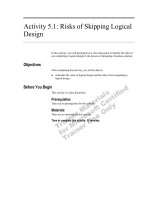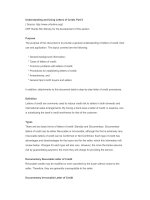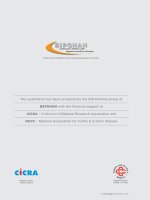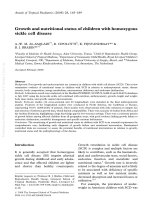Tài liệu Pulmonary Tuberculosis: Detailed History of Presenting Illness (HPI) doc
Bạn đang xem bản rút gọn của tài liệu. Xem và tải ngay bản đầy đủ của tài liệu tại đây (1.74 MB, 11 trang )
Pulmonary Tuberculosis
Pulmonary Tuberculosis Pulmonary Tuberculosis
Pulmonary Tuberculosis
Detailed History of Presenting Illness (HPI)
- Chronic productive cough (occasional haemoptysis) – HAEMOPTYSIS = RED FLAG
resistant to Amoxicillin if previously treated for bronchitis with antibiotics
- Recent onset of night sweats.
- >5kg weight loss.
List of Differential Diagnoses (DDx)
- chronic bronchitis
- pneumonia
- TUBERCULOSIS
- Lung cancer
- asthma
List Pertinent Findings on History (Hx)
Need to check level of English (Interpreter required?)
- Duration of cough complaint
- Productive?
- What colour is it? HAEMOPTYSIS?
- wheeze?
- short of breath? At rest? Duration? Severity?
- How much activity can be sustained before shortness of breath puts a stop to it?
- Chest pain? Exacerbated by coughing or movement?
- Duration of nightsweats?
- Reason to explain weight loss eg diet, loss of appetite?
- Over what period did the weight loss occur?
- Fatigue?
- Joint pain?
Past Hx
- any previous respiratory illnesses? eg pneumonia, TB, chronic bronchitis, asthma.
- Recent Chest XRay? Previous CXR?
- ever been vaccinated against TB (BCG)?
- Ever had a MANTOUX TEST?
- ever had these symptoms before?
- had a recent cold?
- ever been treated with oral steroids? NB oral steroids may predispose patients to tuberculosis.
SHx (Social History)
• Occupational history:
(Important to note exposure to dust in mining industries and factories eg asbestos, coal, silica).
- Has anyone at the workplace been diagnosed with TB?
- Smoking? How many cigarettes/day? How many years? Previously? (?Lung Ca?)
- Alcohol? Amount/day?
FHx (Family History)
- any family Hx of respiratory disease? eg asthma, cystic fibrosis, lung ca…
- Is there any family history of infection with tuberculosis?
- Anyone in family currently unwell or have the same symptoms ie cough, weight loss, night sweats?
- Were you born in whatever country your from?
The incidence of TB in immigrants from the Asian subcontinent is
40 times as common as in the native white population.
List pertinent findings on Examination (Ex)
• Weight (kg)- WOULD BE NICE TO MONITOR LOSS
• TEMPERATURE: FEVER??
• Observation: dyspnoea; chest expansion; breathing pattern; cyanosis; clubbing(!!); cachexia.
• Auscultation (breath sounds and air entry, added sounds) (cardiac)
• Percussion: areas of CONSOLIDATION?
put together by Alex Yartsev: Sorry if i used your images
or data and forgot to reference you. Tell me who you are.
• Cough (dry/moist; effective/ineffective; productive/non-productive)
• Sputum (colour- purulent? haemoptysis? amount; consistency)
• Presence of erythema nodosum? (tender red nodules usually on the shins)
• Lymphadenopathy? (especially hilar and paratracheal lymph nodes)
• Extrapulmonary signs of TB (eg GIT, GUT – kidneys, CNS, skeletal system, skin, eyes, pericardium)
Tests and Investigations
• CHEST X RAY –looking for areas of consolidation
BELOW: marked pleural thickening over the right upper lobe with consolidation in the underlying lung.
• CT Scan (if necessary)
3 consecutive MORNING SPUTUM CULTURES:
• Mycobacterial sputum culture (to isolate and identify M. tuberculosis)
- on Ogana or Lowenstein-Jensen medium(contains MALACHITE GREEN
which inhibits other bacteria) for 4-8 weeks (grows slowly)
OR
- liquid culture – eg Baltec (Becton-Dickinson) which has a shorter culture time (2-3 weeks)
(this has replaced traditional methods above)
-NEED THIS TO TEST FOR ANTIBIOTIC SENSITIVITY+RESISTANCE
• Sputum staining (acid and acid-fast bacilli (AFB) microscopy)
- auramine-rhodamine staining and fluorescence microscopy is used in most modern laboratories.
- light microscopy of specimens stained with Ziehl-Neelsen dyes
(traditional method – more time consuming)- mycoplasma stain RED
normal bacteria stain BLUE
• Fibreoptic bronchoscopy with washings from the affected lobes is useful if no sputum is available.
Transbronchial biopsies may also be obtained for histology and microbiological assessment.
• Biopsies of the pleura, lymph nodes and solid lesions within the lung (tuberculomas) may be
required to confirm the diagnosis.
• Skin testing (MANTOUX)– used for screening (is of limited value in diagnosis because of low sensitivity
and specificity)- BUT in active TB, the skin lesion will be enlarged
FULL BLOOD COUNT:
Lymphopenia may be detected as lymphocytes infiltrate the granulomae
mild anaemia for a variety of reasons, hopefully not haemoptysis
ESR (Erythrocyte sedimentation rate)(how long erythrocytes take to reach the floor of the test
cylinder, in mm/hr)= non-specific indicator of the presence of disease; ill RBCs tend to clump and
thus descend faster THIS WILL BE ELEVATED IN TB
ALSO: TEST RENAL AND LIVER FUNCTION
to see how well the Pt. will cope with the heavy load of antibiotics
How is this diagnosis made ?
Disease Definition
Mycobacterium tuberculosis infection in right lung. Previous infection with Mycobacterium tuberculosis
is normally controlled by T lymphocyte response. Failure of this process leads to reactivation of infection,
chronic granulomatous inflammation in the lung and active tuberculosis leading to cavitating caseous
necrotic foci in the lung parenchyma.
Management
Primary Goal = ISOLATION IN THE HOSPITAL- TB is droplet-transmissible
TREATMENT:
Usually, a COMBINATION of 3 – 4 antimycobacterial drugs
OVER A LONG PERIOD ~6 to 12 months
New Measure: “DOTS” = Directly Observed Therapy Short-course
-where a practitioner observes the patient as they take their antibiotics for a few days a week
THUS BETTER COMPLIANCE
Why its so hard:
Organisms are SLOW-GROWING
Organisms are INTRACELLULAR
Infected cells are SEQUESTERED WITHIN GRANULOMAS
Numerous varied antibiotics = reduced risk of emergence of RESISTANT STRAINS
Synergism of drug combination leads to improved outcome
antibiotic combination: isoniazid, rifampicin, ethambutol and pyrazinamide (streptomycin if drug resistant)
…along with vitamin B6 (pyridoxine).
WHY? Isoniazid, Hydralazine and Penicillamine produce Vit. B6 deficiency.
DISCHARGE FROM HOSPITAL WHEN TMT REGIME IS ESTABLISHED
Epidemiology
TB CAUSES 25% OF ALL PREVENTABLE ADULT DEATHS IN THE DEVELOPING WORLD
8-10 million new cases each year, world-wide
ALSO watch your ZOO MONKEYS: damn dirty humans transmit their TB through bars of cages
Aetiology
TRANSMISSION AND PATHOGENESIS:
PRIMARY INFECTION: very FEW bacteria are required to infect (by AEROSOL DROPLETS)
M.tb are ingested by Alveolar Macrophages where they inhibit lysozyme production
(i.e they gestate inside the macrophagi)
Mycobacterium tuberculosis, has lipoarabinomannan (LAM) – a major
heteropolysaccharide similar in structure to the endotoxin of gram negative bacteria which
inhibits macrophage activation by interferon-gamma and stimulates macrophages to
secrete TNF-alpha (which causes fever, weight loss and tissue damage) and IL-10 (which
suppresses mycobacteria-induced T-cell proliferation). M. TB also synthesises M. TB
heat-shock protein which may induce an autoimmune reaction in some cases.
THEN: MACROPHAGI MIGRATE to regional nodes, and disseminate into the tissue.
After 4-6 weeks aT-cell (CD4+) response develops- they activate and stimulate
macrophages with INTERFERON GAMMA (which causes granulation)
THIS IS THE PRIMARY RESPONSE; it usually controls the infection.
The macrophagi with M.tb inside are sequestered within fibrous TUBERCLES
(often microscopic tiny granulomas)- which eventually heal and calcify
HOWEVER: immunocompromised people may fail to control the infection and develop
PROGRESSIVE PULMONARY DISEASE-with destructive granulomas and cavitation
Or DISSEMINATED (“milliary”) TUBERCULOSIS- lesions in numerous organs,
leading to multi organ system failure
SECONDARY INFECTION: is the development of progressive but localised disease
-MANY YEARS AFTER THE PRIMARY EPISODE- affected persons have no Hx of contact
-why? –because some M.tb may remain active within tubercles
OFTEN a consequence of a steady decline in immune function eg. old age
MOST COMMON SITE = APEX OF LUNG (highest O
2
Tension)
*the GHON FOCUS
is the complex of one fibrotic bundle in the lung and one
associated calcified hilar node- this is visible on X-ray and indicates
a primary infection by TB
PATHOLOGY
CHRONIC INFLAMMATION:
BY DEFINITION a process where TISSUE DAMAGE IS CONCURRENT WITH ATTEMPTS AT REPAIR
it either
- Follows ACUTE INFLAMMATION which never becomes resolved:
- This is called CHRONIC SUPPURATIVE INFLAMMATION
- Ultimately results in FIBROUS SCARRING
- Or begins as a DISTINCT PROCESS from the outset (low-grade smouldering immune response)
- Usually occurs when the body is infiltrated by pathogens which are
- poorly immunogenic eg. M.tb
- persistent (eg. M.tb)
- INSOLUBLE PARTICLES eg asbestos or silica
- Or is the result of continuous hypersensitivity reactions eg. allergy or
autoimmune disease
Tissue damage is resolved through:
1) Resolution: Dead cellular material and debris are removed by phagocytosis (mainly by macrophages) and
the tissue is left with its original architecture intact.
2) Regeneration: Lost tissue is replaced by proliferation of cells of the same type, which reconstruct the
normal architecture.
3) Repair: Lost tissue is replaced by a fibrous scar which is produced from granulation tissue.
Repair:
The process of repair results in formation of a fibrous scar from granulation tissue. The steps in this process
(also termed organisation)are as follows:
4) Phagocytosis of necrotic debris and other foreign material by macrophages.
5) Proliferation of blood vessel endothelial cells and fibroblasts at the edges of the damaged area.
6) Angiogenesis: Endothelial cells grow into the damaged area, initially as solid buds from these adjacent
blood vessels. The solid buds then canalise to form an abundant network of delicate, thin-walled capillaries.
7) Fibroblasts migrate into the damaged area along with the capillaries to form a loose connective tissue
framework. This delicate fibrovascular tissue is granulation tissue.
8) The new capillary vessels anastomose to establish a blood circulation in the healing area and
differentiate towards arterial and venous types as necessary. Fibroblasts produce collagen , giving the
healing tissue mechanical strength.
9) Eventually a mature scar consisting almost entirely of dense collagen is produced. It is a general rule
that the volume of scar tissue produced is always less than the bulk of the tissue it is replacing.
Scar contraction can distort the tissue enough to interfere with function. For example, scarring of tubular
structures such as the intestines can produce stenosis of the lumen and obstruction; scarring of the skin around
a joint can produce contractures and immobility.
The above stages of scar formation do not have to occur in strict sequence and different parts of a developing
scar are in general at different stages at any given moment.
GENERAL FEATURES OF CHRONIC INFLAMMATION:
- INFILTRATION by MACROPHAGES, LYMPHOCYTES and PLASMA CELLS
- GRANULATION tissue
- FIBROSIS and TISSUE DESTRUCTION
- REGENERATION
MACROPHAGES migrate into tissues early and remain if problem is not resolved;
-WILL CONTINUE to produce cytokines etc and thus AGGRAVATE the inflammation
LYMPHOCYTES are attracted by macrophage cytokines and will in turn produce
MACROPHAGE ATTRACTING CYTOKINES and
PLASMA CELL ATTRACTING CYTOKINES
PLASMA CELLS produce antibody and aggravate inflammation eg. R.A.
GRANULATION TISSUE consists of
- Proliferation of FIBROBLASTS
- Small blood vessels stimulated by fibroblasts
- suppurating pus-filled cavities are lined with granulation tissue
(pyogenic membrane)
FIBROSIS AND TISSUE DESTRUCTION is characteristic of chronic inflammation
REGENERATION may result in overgrowth; is most common in EPITHELIAL TISSUE
FEATURES OF CHRONIC GRANULOMATOUS INFLAMMATION:
- SMALL (0.5 to 2 mm) collections of MODIFIED MACROPHAGES: called EPITHELIOID CELLS
(usually surrounded by a rim of lymphocytes)- this results in GRANULOMA FORMATION
- EPITHELIOID CELLS have abundant cytoplasm, are pale pink, and are less phagocytic
- MULTINUCLEATE GIANT CELLS are formed by the fusion of numerous epithelioid cells- may reach enormous
size and have up to 50 nuclei
- TYPE found in TB is the Langhans Giant Cell (horse-shoe shaped pattern of nuclei)
. LYMPHOCYTE PRODUCTS induce these types of macrophage modification
ABOVE: areas of caseous necrosis; pallisading epithelioid macrophages
BELOW: giant cell containing tubercle bacilli
Basic Sciences and Comparitive Diseases
Relevant anatomy
Right lung: 3 lobes:
• Right upper lobe
• Right middle lobe
• Right lower lobe
Left lung: has two lobes:
• Left upper lobe
(includes lingula which
anatomically corresponds
to the middle lobe on
the right lung)
• Left lower lobe
Bare Minimum of Functional Respiratory Anatomy:
Air enters through the external nares.
Conchae @ nose: increase nasal surface area create turbulent flow
Paranasal Sinuses: reduce skull weight, produce mucous, influence voice quality
Just inside the nares the nasal hairs trap large dust particles
In the nasopharynx cilia sweeps remaining particles towards the pharynx to be swallowed
Capillary networks in the nasopharynx WARM AND HUMIDIFY the air
PHARYNX is a common pathway for digestive and respiratory systems
LARYNX includes the thyroid cartilage, cricoid cartilage, and the epiglottis
TRACHEA begins immediately inferior to the cricoid cartilage
- DIVIDES AT T5 (carina)
-Is lined with PSEUDOSTRATIFIED COLUMNAR EPITHELIUM-
- numerous GOBLET cells and cilia for debris clearing
PRIMARY BRONCHI are lined with pseudostratified columnar epithelium
Are supported by C-shaped cartilage rings, like the trachea
SECONDARY+ TERTIARY BRONCHI are very similar but smaller
ALVEOLAR DUCTS and ALVEOLI are lined with SIMPLE SQUAMOUS EPITHELIUM (1 layer of cells)
HISTOLOGY
Behavioural science
Effective Health care of Immigrants
Affected by language, communication and cultural problems
Migrant Acquiescence: the tendency of migrants to smile and nod, never questioning the authority which
they don’t understand.
THUS:-difficult to obtain informed consent
AT RISK are the YOUNG, the OLD and the RECENTLY ARRIVED
Immunology
Systemic Responses to Infection:
Cytokines that exert a systemic effect are produced chiefly by MACROPHAGES
THESE ARE:
- TNF (stimulated by m.tb)
- Il-1 (stimulated by m.tb)
- Il-6
ACUTE CHANGES:
- FEVER (TNF and IL-1 effect the hypothalamus, raising the homeostatic set-point)
- ACUTE PHASE RESPONSE:
- Liver is switched from producing ALBUMIN to producing inflammatory serum proteins
- SUCH AS:
- Complement components
- C-Reactive Protein (CRP)
- Fibrinogen
The Acute Phase Response proteins are a good marker of inflammation
- BONE MARROW: switched by Granulocyte Colony Stimulating Factor (GCSF)
to produce MORE NEUTROPHILS
CHRONIC CHANGES:
- METABOLIC EFFECTS: TNF causes
- FAT AND PROTEIN BREAKDOWN
- ANOREXIA through loss of appetite
- Thus, muscle wasting and weight loss
CATASTROPHIC EFFECTS:
- Massive amounts of the abovementioned cytokines can cause
- Shock by inhibiting myocardial contractility and dilating the blood vessels thus dropping BP
- Lymphopenia by suppression of bone marrow
- Intravascular Thrombosis by upregulating clotting proteins
Prevention of Transmission:
CONTROL OF RESERVOIR
- Reservoir is HUMANS; thus this means ACTIVE CASE DETECTION & MANAGEMENT
- SCREENING of high risk groups
- ISOLATION of suspected cases
- ADEQUATE TREATMENT that does not result in development of DRUG RESISTANCE
CONTROL OF TRANSMISSION
- ADEQUATE VENTILATION
- PREVENTION OF OVERCROWDING
PROTECTION OF HOST
- INCREASE RESISTANCE by BCG vaccination of all high-risk populations
- PREVENTION AND TREATMENT OF UNDERNUTRITION and AIDS
Microbiology
Above: Rhodamine/Auramine stain for above: Ziehl-Neelsen stained smear of sputum.
M. tuberculosis (40X magnification).
SPUTUM CULTURE: below: 4-week-old culture of the patient's sputum on Lowenstein-Jensen medium.
Pharmacology:
Isoniazid*
Mechanism of Action:
Exact mechanism unknown. Mycobacterium - selective antibiotic, bacteriostatic on
resting, bactericidal on dividing bacteria
Dosage 300 mg daily 1/2 hour before breakfast.
Contraindication
Hepatic Disease; Renal disease; Ophthalmolocical function - monitor.
Side Effects
Allergic reactions; Hepatotoxicity; Peripheral Neuropathy;
Blood dyscrasias (due to lack of Vit. B6)
No Risk in Pregnancy
Rifampicin*
Mechanism of Action
Wide-spectrum antibiotic. Inhibits prokaryotic RNA polymerase. Active against most
G+ve and many G-ve organisms.
Dosage 600 mg daily (450 mg if <45 kg weight)
Contraindication Jaundice; Hepatic dysfunction; Meningococcal Tx; Newborn;
Diabetes; Pregnancy; Lactation.
Side Effects GI upset; Headache; Drowsiness; Allergy; Hepatic disturbance;
Contraceptives failure; Bodily secretions stain pink.
NOT FOR USE IN PREGNANCY
Pyrazinamide*
Mechanism of Action
Active (bacteriostatic) at acidic pH of macrophage lysosomes. Exact mechanism unknown.
Dosage Complex
Contraindication Hepatic Disease; Hyperuricaemia; Gout; diabetes; Renal insufficiency; Pregnancy;
Side Effects Hepatic reactions; Hyperuricaemia; Gout.
No Risk in Pregnancy
Ethambutol*
Mechanism of Action
Mycobacteria - specific, bacteriostatic. Mechanism of action unknown.
Dosage Complex
Contraindication Optic neuritis; Renal impairment;
Side Effects Decrease visual acuity; Colour vision loss; GI upset; Arthralgia; Mental disturbances
No Risk in Pregnancy









